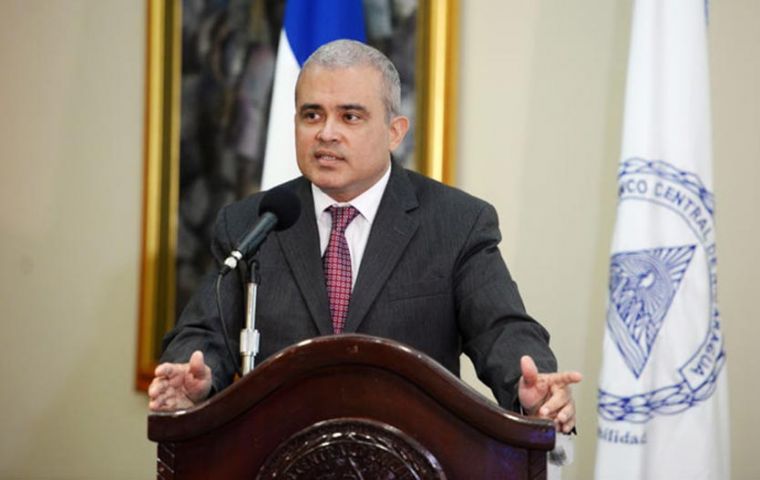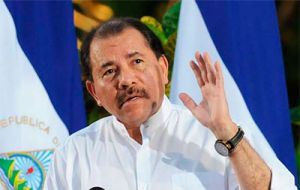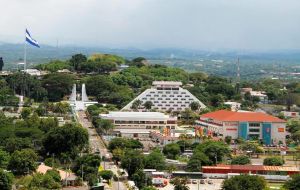MercoPress. South Atlantic News Agency
The other side of Nicaragua's instability: economic growth could drop from 4.9% to 1%.
 Central bank chief Ovidio Reyes said the initial 4.9% GDP growth forecast for 2018 could fall as low as 1% if ongoing protests continue to disrupt daily life
Central bank chief Ovidio Reyes said the initial 4.9% GDP growth forecast for 2018 could fall as low as 1% if ongoing protests continue to disrupt daily life  Sunday marked 103 days since the start of the protests, with the opposition demanding the ouster of President Daniel Ortega and his authoritarian practices
Sunday marked 103 days since the start of the protests, with the opposition demanding the ouster of President Daniel Ortega and his authoritarian practices  According to official figures, more than 300 people have been killed in the clashes. Local human rights groups, however, have put the number at more than 400
According to official figures, more than 300 people have been killed in the clashes. Local human rights groups, however, have put the number at more than 400  Official data shows Nicaragua's economy expanded 4.9% in 2017, driven by tourism, exports and remittances from Nicaraguans living and working abroad.
Official data shows Nicaragua's economy expanded 4.9% in 2017, driven by tourism, exports and remittances from Nicaraguans living and working abroad. Nicaragua's protracted political crisis, which has lasted well over three months, is impairing economic growth, according to the central bank. Central bank chief Ovidio Reyes said the initial 4.9% growth forecast in gross domestic product (GDP) for 2018 could fall as low as 1% if ongoing protests continue to disrupt daily life.
Until June, the central bank registered economic losses of US$ 430 million due to the crisis, with the lost revenue in tourism alone hitting US$ 231 million.
Sunday marked 103 days since the ruling Sandinista National Liberation Front announced social security reforms on April 18, which increased taxes and cut benefits, sparking violent clashes between anti-government protesters and security forces.
While the government was quick to rescind the reforms and call for national dialogue with the opposition, protests have continued, with the opposition demanding the ouster of President Daniel Ortega and his authoritarian practices.
According to official figures, more than 300 people have been killed in the clashes. Local human rights groups, however, have put the number at more than 400, the majority of which protestors, including several journalists and a Brazilian medic. The Ortega administration has appealed to armed gangs for the killings and intimidation.
Official data shows Nicaragua's economy expanded 4.9% in 2017, driven by tourism, exports and remittances from Nicaraguans living and working abroad.
However the Nicaraguan Foundation for Economic and Social Development (Funides), a private-sector group, predicted GDP will fall by 2% if the political unrest persists through the end of the year. The sectors that would sustain the biggest losses include trade, tourism and construction, according to a Funides report.
Barricades along major avenues have interrupted deliveries of goods for days. The president of the Nicaraguan Dairy Chamber, Wilmer Fernandez, said roadblocks led to losses of 1 million dollars over a three-day period in May, by preventing the shipping of perishable products.
After security forces dismantled roadblocks from highways, the outlook appears more “optimistic” than in May, when Nicaragua's monthly economic activity index showed a 4.9% drop, the central bank's Reyes said.
“In July and August of this year, we expect the economy to be able to retake the path of growth,” Reyes said.
The services sector was the worst hit, particularly hotels and restaurants, according to the bank. Political uncertainty has prompted Nicaraguans to withdraw an estimated 600 to 700 million dollars from their bank accounts, official sources say. Meanwhile, the government withdrew up to 100 million dollars from the central bank reserves as of June to pay for “unforeseen expenses” amid the protests.




Top Comments
Disclaimer & comment rulesCommenting for this story is now closed.
If you have a Facebook account, become a fan and comment on our Facebook Page!